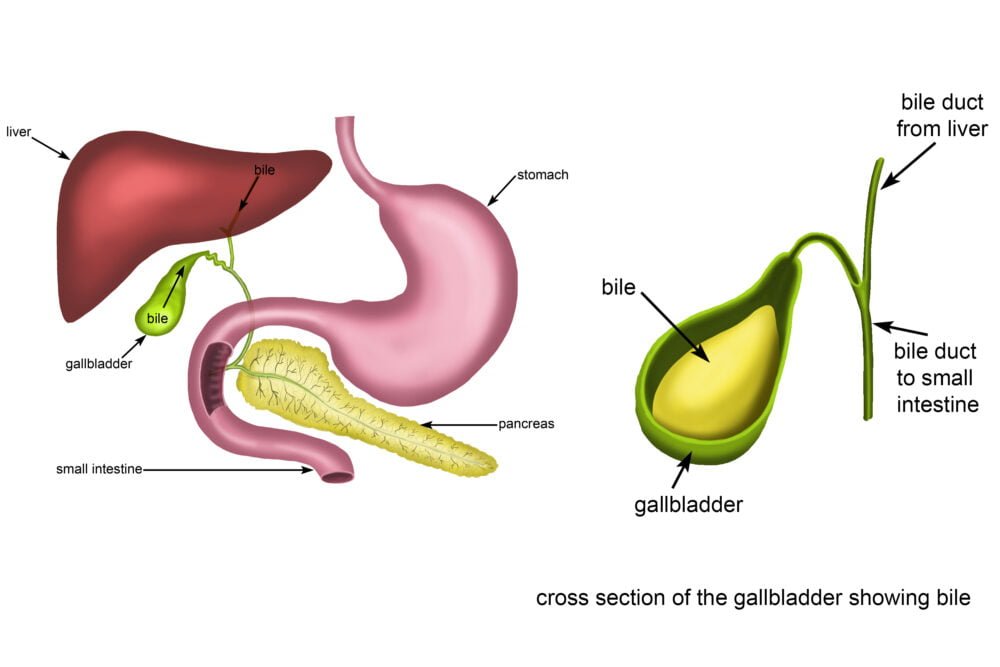What is Bile?
- Bile, often called gall, is like a yellowish-green-brown liquid that our liver makes.
- Almost all animals with a backbone, including us humans, produce bile, and it’s super important for our bodies to work well.
- Our liver cells, called hepatocytes, keep making bile all the time, and it’s stored in a little bag called the gallbladder.
- When we need it, the gallbladder sends the bile to our intestines. Bile is a big deal because it helps break down fats when we’re digesting food in our small intestines. It’s like a digestive superhero for lipids!

Functions of Bile
Bile is a golden-green, digestive fluid produced by the liver and stored in the gallbladder. It plays a crucial role in the digestion and absorption of fats, as well as other important functions in the body. Here are some of the key functions of bile:
Fat Digestion and Absorption
- Bile is essential for breaking down fats in food into smaller particles, called micelles.
- This process, known as emulsification, increases the surface area of the fat, making it easier for digestive enzymes to break it down into fatty acids and glycerol.
- These smaller components can then be absorbed into the bloodstream through the intestinal wall.
- Bile acids, the main components of bile, act like detergents by surrounding the fat molecules with their hydrophilic (water-loving) ends and hydrophobic (water-hating) ends.
- This allows the fat to mix with the watery environment of the small intestine and be broken down more efficiently.
Excretion of Waste Products
- Bile acts as a carrier for waste products from the liver, such as bilirubin, a breakdown product of red blood cells, and excess cholesterol. These waste products are excreted in the faeces, helping to detoxify the body.
- Bilirubin gives bile its characteristic yellow colour. When bile production or flow is impaired, bilirubin can build up in the blood, leading to jaundice, which causes yellowing of the skin and eyes.
Neutralization of Stomach Acid
- Bile helps to neutralize the acidic chyme, a mixture of food and stomach acid, that enters the small intestine from the stomach.
- This creates a more alkaline environment that is optimal for the activity of pancreatic enzymes and protects the intestinal lining from irritation.
Other Functions
Bile also helps to:
- Absorb fat-soluble vitamins, such as A, D, E, and K.
- Control blood sugar levels by regulating the breakdown of carbohydrates.
- They have antibacterial properties that help to protect the intestines from harmful bacteria.
- Stimulate the production of gastric juices in the stomach.
The Function of Bile Summary
- Bile plays a crucial role as a route for excreting bilirubin, a byproduct of red blood cells, and various harmful fat-soluble substances. Bile salts, integral components of bile, aid in breaking down fats and enhancing their absorption in the intestines. The elimination of cholesterol also occurs through the bile.
- Cytokines and IgA are released into the bile, stimulating the innate immune system and protecting the body from enteric infections. Bile is a vital part of both enterohepatic and cholehepatic circulation.
- Additionally, many hormones and pheromones are excreted in the bile, playing a role in the development of the intestine.
Maintaining Bile Health
Bile production and flow can be affected by various factors, such as diet, stress, and certain medical conditions. Maintaining a healthy bile flow is important to ensure proper digestion and absorption of nutrients. Some tips for supporting bile health include:
- Eating a healthy diet rich in fibre and low in processed foods and unhealthy fats.
- Maintaining a healthy weight.
- Managing stress levels.
- Staying hydrated.
If you are experiencing symptoms such as indigestion, heartburn, abdominal pain, or jaundice, it is important to consult a doctor to rule out any underlying medical conditions.
Composition of Bile
- Bile is mostly made up of water, about 95% of it. Within this watery mix, there are dissolved solid bits like bile salts (0.7%), bilirubin (0.2%), and fats (0.51%).
- The fats include cholesterol, fatty acids, lecithin, and other stuff like inorganic salts, vitamins, and environmental toxins.
- Now, the cool part is that bile’s green and yellow colours come from two pigments: biliverdin (like the oxidized form of bilirubin) gives it a green tint, and bilirubin itself brings in that yellow hue. It’s like a colourful cocktail of essential elements!
Frequently Asked Questions
Q1: What are the types of bile salts?
Bile salts come in four varieties: primary, secondary, conjugated, and non-conjugated.
Q2: What is the composition of bile salts?
Bile salts are products of cholesterol metabolism, specifically 24-carbon water-soluble compounds.
Q3: What is the function of bile in the digestive system?
Bile serves the digestive system by emulsifying fats, breaking them down, and facilitating their absorption in the intestine.
Q4: What is the pH of bile?
Bile typically maintains an alkaline pH level of 8.2.

